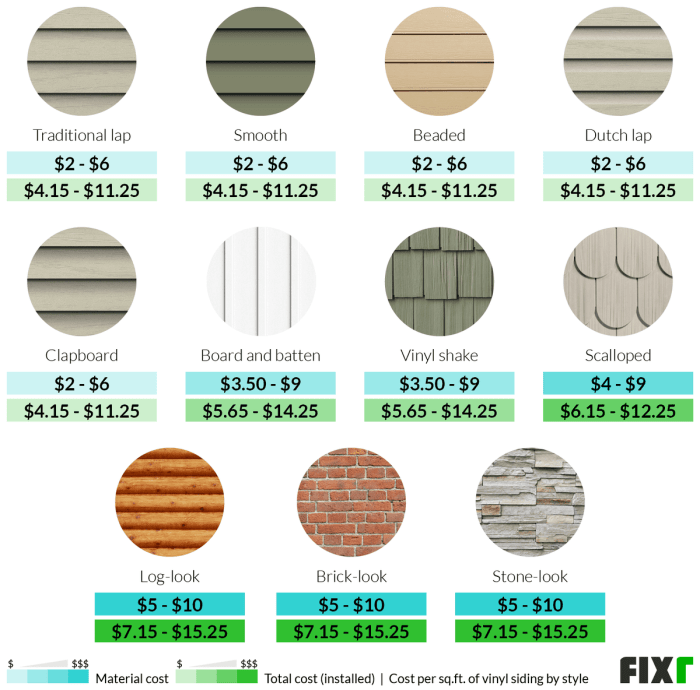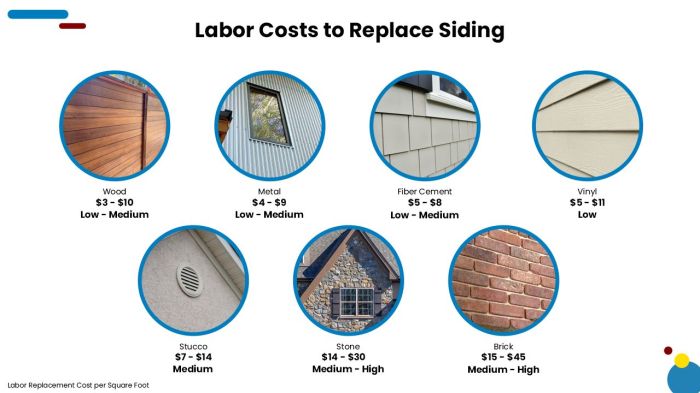Exploring the Average Price for Siding Installation
Delving into the realm of siding installation costs, this article provides an in-depth look at what influences the average prices. From different materials to regional variations, get ready to uncover essential insights that will help you navigate through your siding installation journey.
As we journey through the details of siding installation costs, you'll gain a comprehensive understanding of the factors at play and how they impact your budget.
Factors Affecting Siding Installation Costs
When it comes to the cost of siding installation, several factors can influence the overall price homeowners can expect to pay. Understanding these factors can help homeowners budget accordingly and make informed decisions about their siding projects.
Types of Siding Materials
There are various types of siding materials available, each with its own cost implications. Common options include:
- Vinyl Siding: Affordable and low maintenance, vinyl siding is a popular choice for many homeowners.
- Fiber Cement Siding: Durable and resistant to fire and pests, fiber cement siding tends to be more expensive but offers long-term value.
- Wood Siding: Known for its natural beauty, wood siding can vary in cost depending on the type of wood used.
- Metal Siding: Modern and sleek, metal siding can be a cost-effective option for some homeowners.
Impact of Project Size
The size of the siding installation project can significantly impact the overall cost. Larger projects require more materials and labor, resulting in higher costs. Additionally, complex designs or intricate detailing may also increase the price of the installation.
Role of Labor Costs
Labor costs play a crucial role in determining the average price for siding installation. Experienced contractors may charge higher rates for their expertise, while larger crews may be needed for bigger projects, adding to the overall cost. It's essential to factor in labor costs when budgeting for siding installation.
Additional Costs During Installation
In addition to the cost of materials and labor, homeowners may also incur additional expenses during the siding installation process. These can include:
- Permit Fees: Some areas require permits for siding installation, which can add to the overall cost.
- Removal and Disposal: Removing old siding and disposing of it properly can result in additional charges.
- Repairs: If underlying issues are discovered during the installation, repairs may be necessary, leading to extra costs.
- Trim and Accessories: Adding trim or decorative elements to the siding can increase the final price of the project.
Average Cost Comparison of Different Siding Materials

When considering siding materials for your home, it is important to factor in the average cost along with other key aspects such as durability, maintenance requirements, and energy efficiency benefits. Here, we will compare the average prices of popular siding materials and delve into their characteristics.
Vinyl Siding
Vinyl siding is one of the most affordable options, with an average cost ranging from $3 to $7 per square foot. It is known for its low maintenance requirements, as it does not need to be painted and is resistant to rot and pests.
However, vinyl siding may not be as durable as other materials and can crack or fade over time.
Wood Siding
Wood siding typically costs between $6 to $10 per square foot, making it a mid-range option. It offers a classic and natural look to your home but requires regular maintenance such as painting or staining to prevent rot and insect damage.
Wood siding is prone to warping and cracking, especially in extreme weather conditions.
Fiber Cement Siding
Fiber cement siding falls in the higher price range, averaging between $5 to $12 per square foot. This material is highly durable, resistant to fire, insects, and rot. It requires minimal maintenance and can mimic the look of wood or stucco.
Fiber cement siding is also known for its energy efficiency, providing better insulation for your home and potentially reducing long-term heating and cooling costs.By comparing the average costs and characteristics of these siding materials, homeowners can make an informed decision based on their budget, maintenance preferences, and desired energy efficiency benefits.
Regional Variances in Siding Installation Prices
When it comes to siding installation prices, the location plays a significant role in determining the average cost. Factors such as labor costs, material availability, and local regulations can all impact how much you'll pay for siding installation in different regions.In regions where the cost of living is higher, such as major cities or affluent neighborhoods, you can expect siding installation prices to be above the national average.
On the other hand, rural areas or regions with lower costs of living may have siding installation costs that are below the national average.
Impact of Local Regulations and Building Codes
Local regulations and building codes can also influence the overall cost of siding installation. Some areas may have strict requirements for siding materials or installation methods, which can drive up costs. For example, if a region requires a specific type of siding material that is more expensive or labor-intensive to install, you can expect to pay more for your siding project in that area.In conclusion, when planning for siding installation, it's important to consider the regional variances in pricing.
Understanding how location, local regulations, and building codes can impact costs will help you budget accordingly for your siding project.
Tips for Budgeting and Saving on Siding Installation
When it comes to siding installation, homeowners often look for ways to save money without compromising on quality. Here are some tips to help you budget effectively and reduce costs:
Obtaining Multiple Quotes
One of the most effective ways to save on siding installation costs is to obtain multiple quotes from different contractors. This allows you to compare prices, services offered, and the quality of work. By doing so, you can ensure that you are getting the best value for your money.
Exploring Financing Options
Another way to offset siding installation expenses is to explore financing options or incentives. Some contractors may offer financing plans that allow you to spread out the cost of installation over time. Additionally, there may be government incentives or rebates available for energy-efficient siding materials, which can help reduce your overall expenses.
End of Discussion

Wrapping up our discussion on the average price for siding installation, it's clear that this crucial aspect of home improvement requires careful consideration and planning. Armed with the knowledge shared here, you're better equipped to make informed decisions when it comes to enhancing your home's exterior.
FAQ Explained
What are the most common types of siding materials used for installation?
Common siding materials include vinyl, wood, fiber cement, and aluminum.
How can homeowners save on siding installation costs?
Homeowners can save by obtaining multiple quotes, exploring financing options, and considering DIY options for simpler projects.
Do different regions have varying average prices for siding installation?
Yes, regional factors such as labor costs and material availability can influence the overall cost of siding installation.




